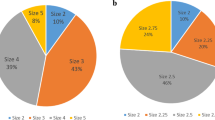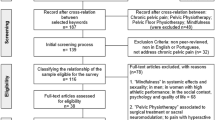Abstract
Introduction
Pelvic organ prolapse(POP) has an adverse impact on quality of life with lifetime risk of surgery varying from 11 to 20%. Conditions such as fibromyalgia (FMS), chronic fatigue syndrome (CFS/ME) and irritable bowel syndrome (IBS), collectively known as central sensitivity syndromes (CSS), may affect the outcome of POP surgery. The aim of this article is to compare the outcomes of vaginal POP surgery between women with and without CSS.
Method
This was a prospective cohort study. The validated Central Sensitisation Inventory (CSI) was used to identify women with CSS. Subjective and objective outcomes were compared between the two groups using POP-SS, Expectation and satisfaction/“EGGS”, pain scores and the POP quantification system (POP-Q). A non-parametric test was used for analysis.
Result
Seventy-eight women were recruited. Complete data were available in 62 patients; 23 patients had evidence of CSS and 39 did not. Women with CSS had significantly higher pre- and post-operative POP-SS scores than those without (p < 0.0005, p = 0.004). Seventeen (73.9%) women with CSS compared to 38 (97.4%) women without CSS demonstrated improvement of a minimum 6 points on the POP-SS scale; however, this was not stastically significant. McGill’s pain scores were higher in women with CSS both pre- and post-surgery. Ninety-five per cent of women without CSS achieved their goals and were satisfied with the surgery compared to 69.5% of women with CSS (p < 005).
Conclusion
There is a less favourable outcome of POP surgery in women with CSS compared to those without in terms of persistence of symptoms, pain and overall satisfaction.

Similar content being viewed by others
References
Vitale SG, Caruso S, Rapisarda AM, et al. Biocompatible porcine dermis graft to treat severe cystocele: impact on quality of life and sexuality. Arch Gynecol Obstet. 2016;293:125–31.
Mirskaya M, Lindgren E, Carlsson I. Online reported women’s experiences of symptomatic pelvic organ prolapse after vaginal birth. BMC Womens Health. 2019;19:129. https://doi.org/10.1186/s12905-019-0830-2.
Retrospective Review of Surgery for Urogynaecological Prolapse and Stress Urinary Incontinence using Tape or Mesh: Hospital Episode Statistics (HES), Experimental Statistics, April 2008–March 2017. https://digital.nhs.uk/data-and information/publications/statistical/mesh/apr08-mar17
The Baroness Cumberledge report-First do no harm (2020). https://www.immdsreview.org.uk/downloads/IMMDSReview_Web.pdf
Mattsson NK, Karjalainen P, Tolppanen A-M. Pelvic organ prolapse surgery and quality of life—a nationwide cohort study. Am J Obstet Gynecol. 2020;222(588):e1–10.
Yunus MB. Central sensitivity syndromes: a new paradigm and group nosology for fibromyalgia and overlapping conditions, and the related issue of disease versus illness. Semin Arthritis Rheum. 2008;37(6):339–52.
Adams K, Osmundsen B, Gregory WT. Does fibromyalgia influence symptom bother from pelvic organ prolapse? Int Urogynecol J. 2014;25:677–82.
Gwilym SE, Oag HC, Tracey I, Carr AJ. Evidence that central sensitisation is present in patients with shoulder impingement syndrome and influences the outcome after surgery. J Bone Joint Surg (Br). 2011;93(4):498–502.
Toozs-Hobson P, Freeman R, Barber M, Maher C, Haylen B, Athanasiou S, et al. An International Urogynecological Association (IUGA)/International Continence Society (ICS) joint report on the terminology for reporting outcomes of surgical procedures for pelvic organ prolapse. Neurourol Urodyn. 2012;31(4):415–21.
Mayer TG, Neblett R, Cohen H, Howard KJ, Choi YH, Williams MJ, et al. The development and psychometric validation of the central sensitization inventory. Pain Pract. 2012;12:276–85.
Neblett R, Hartzell M, Mayer TG, Cohen H, Gatchel RJ. Establishing clinically relevant severity levels for the central sensitization inventory. Pain Practice: Off J World Inst Pain. 2016;17(2):166–75.
Srikrishna S, Robinson D, Cardozo L. Validation of the patient global impression of improvement (PGI-I) for urogenital prolapse. Int Urogynae J. 2010;21(5):523–8.
Hagen S, Glazener C, Sinclair L, Stark D, Bugge C. Psychometric properties of the pelvic organ prolapse symptom score. BJOG Int J Obstet Gynaecol. 2009;116(1):25–31.
Melzack R. The short-form McGill pain questionnaire. Aug. 1987;30(2):191–7.
Brubaker L, Shull B. EGGS for patient-centered outcomes. Int Urogynecol J Pelvic Floor Dysfunct. 2005;16:171–3.
Bump RC, Mattiasson A, Bø K, et al. The standardization of terminology of female pelvic organ prolapse and pelvic floor dysfunction. Am J Obstet Gynecol. 1996;175:10–7.
Wu JM, Vaughan CP, Markland AD, et al. Prevalence and trends of symptomatic pelvic floor disorders in US women. Obstet Gynecol. 2014;123(1):141–8.
Ablin JN, Berman M, Aloush V, Regev G, Salame K, Buskila D, et al. Effect of fibromyalgia symptoms on outcome of spinal surgery. Pain Med. 2017;18:773–80.
Lopiz Y, Marcelo H, Arvinius C, Rodriguez-Rodriguez L, García-Fernández C, Marco F. Is fibromyalgia a cause of arthroscopic subacromial decompression failure? Rev Esp Cir Ortop Traumatol. 2019;63(4):275–80.
Dolores Carrilo-Izquierdo M, Slim M, Hidalgo-Tallon J, Calandre PE. Pelvic floor dysfunction in women with fibromyalgia and control subjects: prevalence and impact on overall symptomatology and psychosocial function. Neurourol Urodyn. 2018;37(8):2702–9.
Jones KD, Maxwell C, Mist SD, King V, Denman AM, Gregory WT. Pelvic floor and urinary distress in women with fibromyalgia. Pain Manag Nurs. 2015;16(6):834–40.
Kehlet H, Jensen TS, Woolf CJ. Persistent post-surgical pain: risk factors and prevention. Lancet. 2006;367:1618–25.
Gerbershagen HJ, Dagtekin O, Gaertner J, et al. Preoperative chronic pain in radical prostatectomy patients: preliminary evidence for enhanced susceptibility to surgically induced pain. Eur J Anaesthesiol. 2010;27:448–54.
Hinrichs-Rocker A, Schulz K, Jarvinen I. Psychosocial predictors and correlates for chronic post-surgical pain (CSPP)—a systematic review. Eur J Pain. 2009;13:719–30.
Theunissen M, Peters ML, Schepers J, et al. Recovery 3 and 12 months after hysterectomy: epidemiology and predictors of chronic pain, physical functioning, and global surgical recovery. Medicine. 2016;95:e3980.
Lewis GN, Rice DA, McNair PJ, Kluger M. Predictors of persistent pain after total knee arthroplasty: a systematic review and meta-analysis. Br J Anaesth. 2015;114:551–61.
Borsook D, Kussman BD, George E, Becerra LR. A review on surgically induced neuropathic pain—understanding the perioperative process. Ann Surg. 2013;257(3):403–12.
Geller EJ, Babb E, Zolnoun D. Incidence and risk factors for pelvic pain after mesh implant surgery for the treatment of pelvic floor disorders. J Minim Invasive Gynecol. 2017;24(1):67–73.
Offiah I, Dilloughery E, McMahon SB, O’Reilly BA. Prospective comparative study of the effects of lidocaine on urodynamic and sensory parameters in bladder pain syndrome. Int Urogynecol J. 2019;30(8):1293.
Schrepf A, Moser S, Harte SE, Basu N, Kaplan C, Kolarik E, et al. Top down or bottom up? An observational investigation of improvement in fibromyalgia symptoms following hip and knee replacement. Rheumatology (Oxford). 2019;59(3):594–602. https://doi.org/10.1093/rheumatology/kex303.
Baert I, Lluch E, Mulder T, Nijs J, Noten S, Meeus M. Does pre-surgical central modulation of pain influence outcome after total knee replacement? A systematic review. Osteoarthr Cartil. 2016;24(2):213–23.
Author information
Authors and Affiliations
Corresponding author
Ethics declarations
Conflict of interest
None.
Additional information
Publisher’s note
Springer Nature remains neutral with regard to jurisdictional claims in published maps and institutional affiliations.
Rights and permissions
About this article
Cite this article
Vij, M., Dua, A., Davies, A. et al. Do patients with central sensitivity syndromes have poor subjective outcomes despite anatomical cure from pelvic organ prolapse surgery?. Int Urogynecol J 32, 1461–1467 (2021). https://doi.org/10.1007/s00192-020-04655-0
Received:
Accepted:
Published:
Issue Date:
DOI: https://doi.org/10.1007/s00192-020-04655-0




